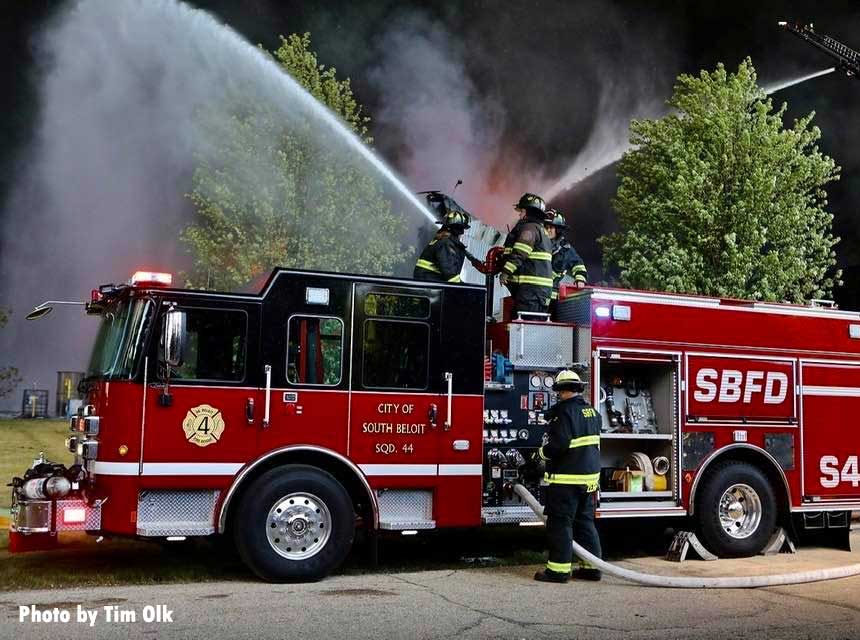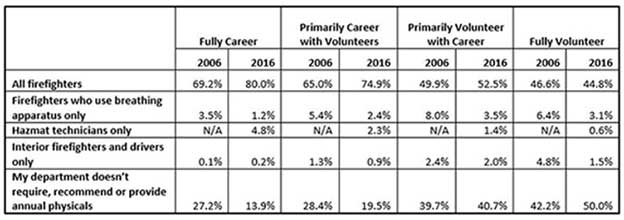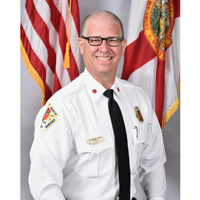
We have all come to know and hopefully embrace the concept of Community Risk Reduction, which aims to identify and mitigate risks within our service areas before it “boils over”. As the old adage goes, “an ounce of prevention is worth a pound of cure.”
When it comes to our firefighting, personnel we may need to apply some of the same embraced principles. Sadly, according to a 2015 fire service needs assessment conducted and published by the National Fire Protection Association (NFPA), only 27 percent of departments had a basic firefighter fitness and health program, and only 20 percent had a behavioral health program.
This is very similar to what the International Association of Fire Chiefs found when they surveyed their membership in 2016 as to how many departments some type of annual medical physical and are being proactive with addressing occupational health risk. The chart below shows much work still is to be done to assure every firefighter in the United States fire service receives and annual occupationally appropriate physical.
At nearly every conference presentation, including most recently Fire Rescue 2021 held by the International Association of Fire Chiefs in Charlotte, North Carolina, I ask attendees to stand if they have lost a fellow service member to cardiac event, cancer, or suicide. There is not a single class that I have had the honor of teaching where the entire room is not standing, signifying the magnitude of the occupational health and death risk to firefighters despite the light being shined brightly on the issue.

The Essential Elements of Community Risk-Reduction
It is also interesting to note that fire departments pay close attention to preventative maintenance of their apparatus, and rightly so given the inherent risks of not so doing. We would never put firefighters on apparatus that had bald tires, spongy brakes and not seat belts, knowing this would be a predictable disaster.
So what then is “human risk reduction” (HRR) and how do we continue to invest in it and think of it? At its very basic level, human risk reduction focuses on mitigating the known risks are firefighters face to their health based on the profession we have chosen and the tasks that are expected of us.
Does your department have prevention and risk reduction programs in place to reduce heat stress, enhance carcinogenic exposure reduction, and support mental and physical resiliency? Have you invested in physical and mental fitness programs and nutritional awareness to condition the body and the mind for the rigors of the environment which first responders operate in? Have you focused your educational efforts on healthy lifestyle habits, include sleep hygiene for your firefighters? Lastly, have you invested in providing comprehensive early detection physicals to provide a baseline of your firefighters wellness that is repeated annually to assure early detection and prevention?
These are investments in human risk reduction. If we introspectively ask ourselves what are we investing in our apparatus and how does that compare to what we are investing in our human risk reduction programs, perhaps a continuing paradigm of human risk reduction will continue to evolve and take root.

Todd J. LeDuc, MS, CFO, FIFirE, retired after nearly 30 years as assistant fire chief of Broward County, Florida, an internationally accredited career metro department. He served as chief strategy officer for Life Scan Wellness Centers, a national provider of comprehensive physicals and early detection exams. He has served as a member of the International Association of Fire Chief’s Safety, Health & Survival Section for over a decade and is currently secretary of the section. He is a peer reviewer for both professional credentialing and agency accreditation. He is editor of Surviving the Fire Service (Fire Engineering Books) and serves on numerous advisory boards and publications. He can be contacted at Todd. LeDuc@lifescanwellness.com.
MORE
Transformational Change and Fire Service Survival
Obesity in the Fire Service: A Tale of Two Camps of Firefighters

